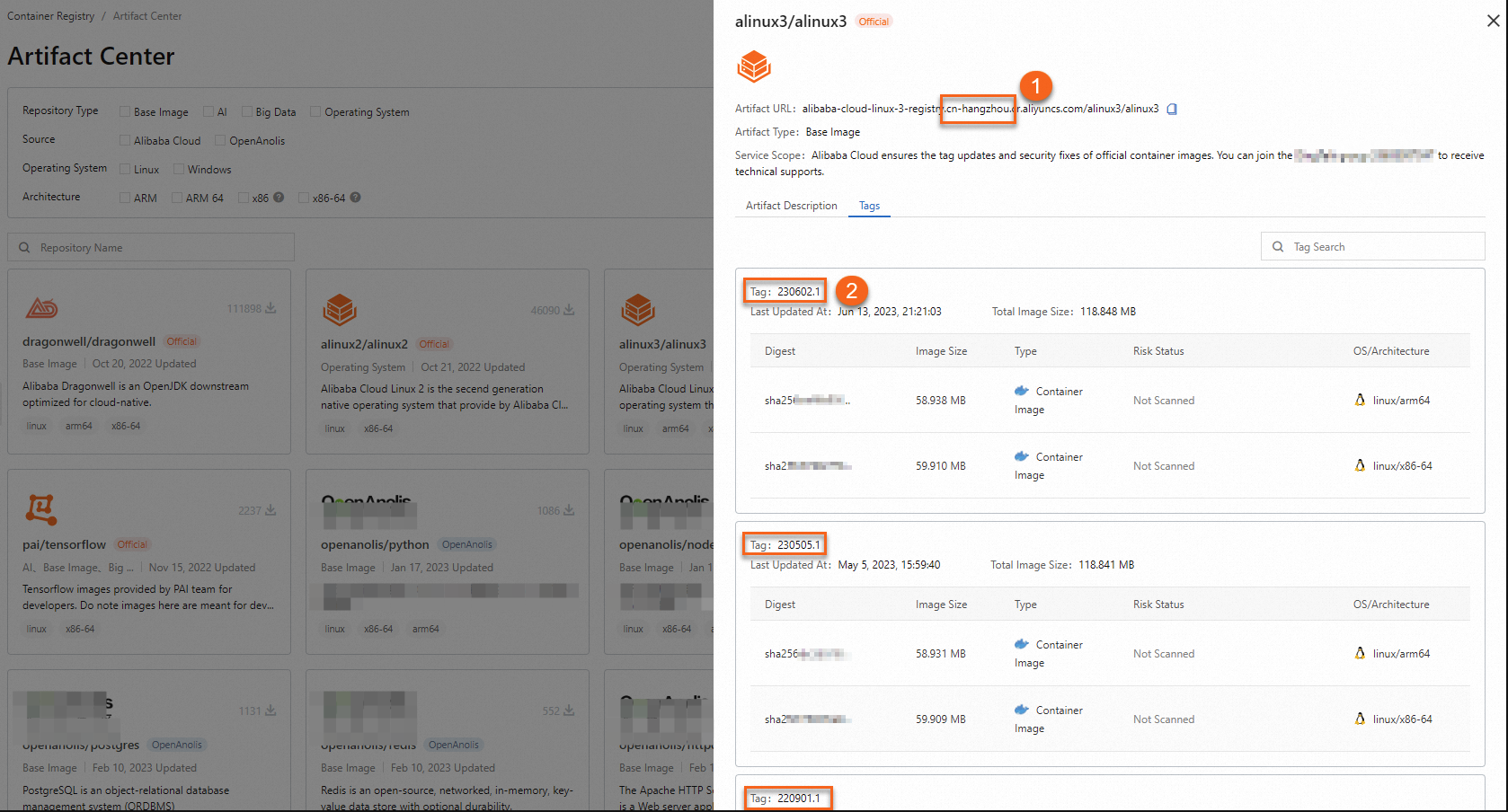Alibaba Cloud provides official Alibaba Cloud Linux-based Docker images that are regularly updated and maintained. The images contain the latest operating system features, functions, and security patches. You can select an Alibaba Cloud Linux image version and build and deploy containerized applications on Elastic Compute Service (ECS) instances. This topic describes how to download, use, and delete an Alibaba Cloud Linux container image in Docker.
Create a Docker container based on an Alibaba Cloud Linux image
Run the following command to download an Alibaba Cloud Linux Docker image:
sudo docker pull alibaba-cloud-linux-<image_version>-registry.<region_ID>.cr.aliyuncs.com/alinux<image_version>/alinux<image_version>:<TAG><image_version>: the Alibaba Cloud Linux version. Example: 2 or 3.<region_ID>: the region ID of the Docker image. Example:cn-hangzhou.<TAG>: optional. The tag of the Docker image. If you specify this parameter, the specified Docker image version is downloaded. Otherwise, the latest Docker image version is downloaded.
Sample commands:
Download version 220901.1 of the Alibaba Cloud Linux 3 Docker image in the China (Hangzhou) region:
sudo docker pull alibaba-cloud-linux-3-registry.cn-hangzhou.cr.aliyuncs.com/alinux3/alinux3:220901.1Download the latest version of the Alibaba Cloud Linux 2 Docker image in the China (Hangzhou) region:
sudo docker pull alibaba-cloud-linux-2-registry.cn-hangzhou.cr.aliyuncs.com/alinux2/alinux2
Run the following command to check whether the images are downloaded:
sudo docker imagesThe following output shows that version 220901.1 of the Alibaba Cloud Linux 3 Docker image and the latest version of the Alibaba Cloud Linux 2 Docker image are downloaded.

Run the following command to create a Docker container and access it:
sudo docker run -it alibaba-cloud-linux-<image_version>-registry.<region_ID>.cr.aliyuncs.com/alinux<image_version>/alinux<image_version>:<TAG> /bin/bash<image_version>: the Alibaba Cloud Linux version. Example: 2 or 3.<region_ID>: the region ID of the Docker image. Example:cn-hangzhou.<TAG>: optional. The tag of the Docker image. If you specify this parameter, the specified Docker image version is downloaded. Otherwise, the latest Docker image version is downloaded.
Sample commands:
Create a Docker container from version 220901.1 of the Alibaba Cloud Linux 3 Docker image in the China (Hangzhou) region:
sudo docker run -it alibaba-cloud-linux-3-registry.cn-hangzhou.cr.aliyuncs.com/alinux3/alinux3:220901.1 /bin/bashCreate a Docker container from the latest version of the Alibaba Cloud Linux 2 Docker image in the China (Hangzhou) region:
sudo docker run -it alibaba-cloud-linux-2-registry.cn-hangzhou.cr.aliyuncs.com/alinux2/alinux2 /bin/bash
 Note
NoteAfter you access the Docker container, you can directly use it.
After the operations are complete, you can run the
exitcommand to exit the Docker container.
(Optional) Restart and access the Docker container.
If you run the
exitcommand to exit the Docker container, the container automatically stops. To continue using the container, restart and access it.Run the following command to query the ID of the created Docker container:
sudo docker ps -aThe following output shows the
CONTAINER IDparameter, which indicates the container ID.
Run the following command to start the Docker container:
sudo docker start <CONTAINER ID>Replace
<CONTAINER ID>with your Docker container ID.After the container is started, you can run the
sudo docker pscommand to query running containers. The following output displays the Alibaba Cloud Linux 3 Docker container in the Up state, which means that the container is running.
Run the following command to access the Docker container:
Replace
<CONTAINER ID>with your Docker container ID.sudo docker exec -it <CONTAINER ID> /bin/bashThe following output shows that you accessed the Alibaba Cloud Linux 3 Docker container.

Delete a Docker container and a Docker image
If you no longer need a deployed Docker container and image, delete them to save resources.
Run the following command to stop a Docker container.
Replace
<CONTAINER ID>with your Docker container ID.sudo docker stop <CONTAINER ID>Run the following command to delete the Docker container.
Replace
<CONTAINER ID>with your Docker container ID.sudo docker rm <CONTAINER ID>Run the following command to view all Docker containers:
sudo docker ps -aThe following output shows that the Docker container is deleted.

Run the following command to view the Docker image names:
sudo docker imagesIn the output shown in the following figure, the
<REPOSITORY>column contains the Docker image names.
Run the following command to delete a Docker image.
Replace
<REPOSITORY>with your Docker image name.sudo docker rmi <REPOSITORY>The following output shows that the Alibaba Cloud Linux 2 Docker image is deleted.

References
For more information about how to use Docker, see Docker documentation.
You can also use container orchestration tools such as Docker Compose to manage and run Docker. Alibaba Cloud also provides Container Registry, which helps you easily manage and run containerized applications.
